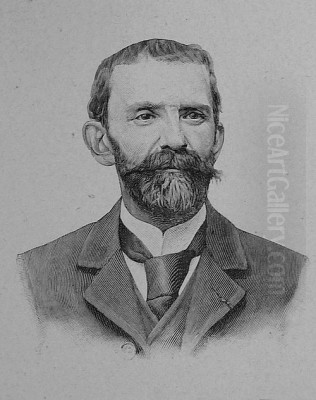
Victor Gabriel Gilbert stands as a significant figure in French art during the late nineteenth and early twentieth centuries. A Parisian by birth and spirit, his canvases vividly capture the bustling energy, everyday moments, and unique atmosphere of his beloved city, particularly its famous markets and street life. Bridging the gap between Realism and the burgeoning Impressionist movement, Gilbert developed a distinctive style appreciated for its vibrant color, keen observation, and sympathetic portrayal of ordinary Parisians. Though lacking formal academic training, his innate talent and dedication earned him considerable recognition during his lifetime, leaving behind a legacy of works that continue to charm and inform viewers about life in the Belle Époque era.
Early Life and Artistic Beginnings
Victor Gabriel Gilbert was born in Paris on May 13, 1847. Unlike many of his contemporaries who benefited from formal instruction at prestigious institutions like the École des Beaux-Arts, Gilbert's path into the art world was shaped by economic necessity. His family's modest means precluded an expensive academic education. Consequently, at the young age of thirteen, Gilbert began an apprenticeship not in a fine art studio, but under Eugène Adam, who worked as both a painter and a decorator.
This practical training, while different from the academic route, provided Gilbert with foundational skills in handling paint and understanding composition. Crucially, it kept him grounded in the world of craft and everyday labor, an experience that would later inform the subject matter of his paintings. To supplement his apprenticeship, Gilbert dedicated his evenings to attending art classes at the École de la Ville de Paris. This represented his only formal artistic instruction, highlighting his determination and reliance on self-teaching to hone his craft. His early years were thus characterized by practical work and diligent independent study, fostering a close connection to the urban environment he would later depict so masterfully.
The Path to Recognition: The Salon and Père Martin
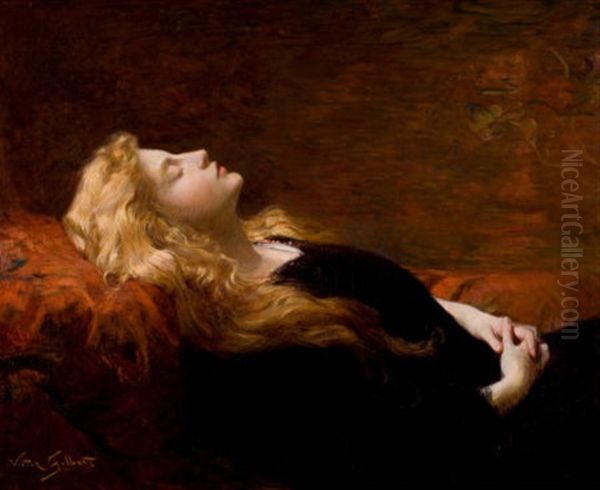
Gilbert's ambition extended beyond decorative work. He aspired to be recognized as a fine artist, and the primary avenue for achieving this in nineteenth-century France was the official Paris Salon. Organized by the Académie des Beaux-Arts, the Salon was the most important art exhibition in the world, capable of making or breaking an artist's career. Gilbert made his debut at the Salon in 1873, initially exhibiting still life paintings, a genre often favored by artists seeking to demonstrate technical skill.
His talent did not go unnoticed. A pivotal moment in his career came through his connection with Père Martin (Pierre Martin), a highly influential art dealer and an early champion of the Impressionists. Martin operated a gallery on the Rue Lafitte, a hub for avant-garde art, and represented artists who would become legends, including Claude Monet, Camille Pissarro, Alfred Sisley, Edgar Degas, Pierre-Auguste Renoir, Paul Cézanne, and even Vincent van Gogh and Paul Gauguin during their early Paris years.
Recognizing Gilbert's potential, Père Martin began purchasing his works and providing crucial financial support. This patronage was instrumental, allowing Gilbert to transition from his work as a decorator and apprentice to dedicating himself entirely to painting. Martin's belief in Gilbert, placing him alongside future giants of modern art, underscores the quality and appeal of Gilbert's early work and provided the stability needed for his artistic development.
Capturing the Heart of Paris: Les Halles and Market Scenes
While Gilbert began with still lifes, he soon found his true calling in depicting the vibrant, teeming life of Paris's central markets, particularly Les Halles. This vast marketplace, famously dubbed "the belly of Paris" by the novelist Émile Zola in his novel Le Ventre de Paris (1873), was the pulsating heart of the city's food supply. It was a world unto itself, filled with vendors, shoppers, porters, and an astonishing variety of goods, from fresh produce and flowers to fish and meat.
Gilbert became the preeminent painter of Les Halles. He possessed an extraordinary ability to capture the specific atmosphere of the market at different times of day – the cool, early morning light, the midday bustle, the specific textures of fish scales, flower petals, or vegetable crates. His paintings are not mere topographical records; they are imbued with life, energy, and a deep sense of place. He often focused on the fish market and the flower market, drawn to the glistening surfaces and vibrant colors these subjects offered.
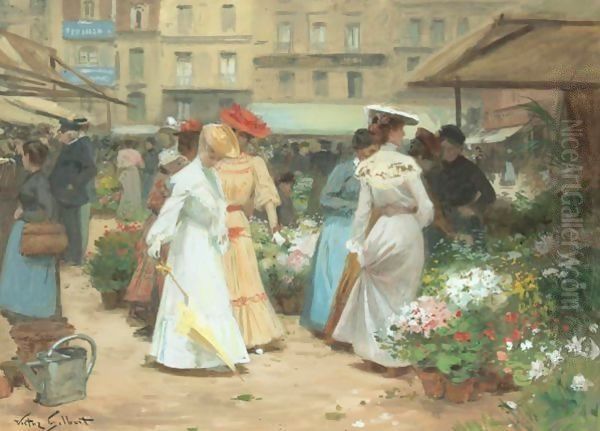
His breakthrough work in this genre was arguably Un Coin du marché aux poissons, le matin (Market Corner, Morning, Fish), exhibited at the Salon of 1880. This painting earned him a second-class medal and cemented his reputation as a master of the market scene. Other notable works like Le Carreau des Halles further demonstrate his fascination with this environment. Gilbert’s detailed realism in rendering the goods and the people, combined with an increasingly bright palette and attention to light effects, set his market scenes apart. He captured the social fabric of the market, portraying the vendors and workers with dignity and individuality.
Style Evolution: From Realism towards Impressionism
Victor Gabriel Gilbert's artistic style evolved significantly throughout his long career, reflecting the broader shifts occurring in the French art world. His early training and inclinations placed him firmly within the Realist tradition. Like Gustave Courbet and Jean-François Millet before him, Gilbert focused on depicting contemporary life and ordinary people without idealization. His early market scenes, while detailed, show a commitment to representing the tangible reality of Parisian life. Influences like François Ribot, known for his kitchen still lifes and genre scenes, can also be discerned in Gilbert's early attention to texture and form.
However, living and working in Paris during the rise of Impressionism inevitably impacted Gilbert's work. He absorbed the Impressionists' interest in capturing fleeting moments, the effects of light and atmosphere, and the vibrancy of modern urban life. While he never fully abandoned realistic detail and structure in the way Monet or Pissarro did, his palette brightened considerably, and his brushwork became looser and more expressive over time.
He became particularly adept at rendering sunlight filtering through the glass roofs of Les Halles or illuminating a colorful flower stall. His approach can be compared to that of Eugène Boudin, a mentor figure to Monet, known for his luminous beach scenes and skies. Gilbert adopted some Impressionist techniques – brighter colors, visible brushstrokes, en plein air sensibility (though many market scenes were likely finished in the studio) – but integrated them into a framework that retained a strong sense of narrative and social observation. He remained, in essence, a genre painter whose realism was enhanced and enlivened by Impressionist discoveries about light and color.
Beyond the Markets: Other Subjects
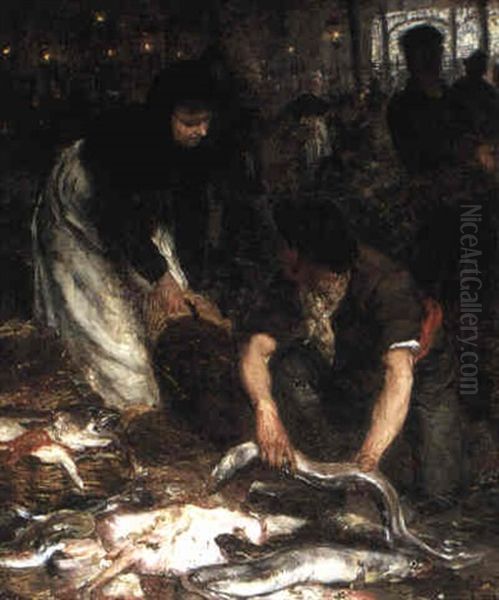
While Gilbert is most renowned for his depictions of Les Halles, his artistic interests extended to other facets of Parisian life and beyond. He frequently painted flower markets located elsewhere in the city, such as the Marché aux Fleurs near Notre Dame. These works allowed him to explore brilliant arrays of color and delicate textures, often focusing on the interactions between the female vendors and their customers. These scenes possess a lighter, more charming atmosphere compared to the sometimes gritty realism of the central food markets.
Children were another favorite subject for Gilbert. He depicted them playing in parks, accompanying their mothers to market, or in quiet domestic settings. Works like Sleeping Beauty showcase his ability to capture childhood innocence and tenderness. He also painted scenes featuring elegant Parisian women, sometimes browsing shops or enjoying leisure time, placing him in dialogue with contemporaries like Jean Béraud, who also specialized in chronicling fashionable Parisian society.
Furthermore, Gilbert produced paintings of rural life and landscapes, although these are less common than his urban scenes. Works like The Milkmaid in Winter demonstrate his ability to handle different settings and moods. Occasionally, he even tackled religious themes, such as his painting L’Église de la Sainte-Trinité, Place de la Trinité, Paris. This diversity of subject matter reveals an artist continually observing the world around him, finding beauty and interest in various aspects of contemporary French life, from the bustling city center to quieter moments.
Recognition and Later Career
Gilbert's dedication and evolving style brought him considerable success and official recognition throughout his career. Following his second-class medal at the Salon of 1880, his reputation grew steadily. He became a member of the Société des Artistes Français, the organization that took over the running of the official Salon after the French state relinquished control. His participation in their annual exhibitions was consistent.
In 1889, a significant year marked by the Exposition Universelle in Paris (for which the Eiffel Tower was built), Gilbert was awarded a silver medal by the Société des Artistes Français, further solidifying his standing in the art establishment. His paintings were popular not only in France but also internationally, finding buyers in Europe and North America, facilitated by dealers who appreciated the appeal of his charming Parisian scenes.
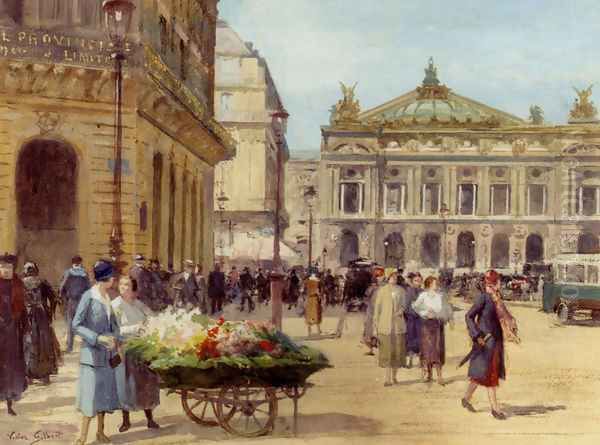
His long career was capped by receiving the prestigious Prix Bonnat in 1926. Named after the influential academic painter Léon Bonnat, this award recognized Gilbert's lifetime achievement and contribution to French art. He continued to paint into his later years, remaining faithful to his preferred subjects of Parisian life. Victor Gabriel Gilbert passed away in Paris on July 21, 1933, and was buried in the Montparnasse Cemetery, leaving behind a substantial body of work that documented a specific era of his city.
Contemporaries and Influences
Victor Gabriel Gilbert navigated the complex art world of late nineteenth and early twentieth-century Paris, interacting with and responding to various artistic currents. His initial apprenticeship was under the painter-decorator Eugène Adam, and he reportedly also received guidance from the landscape painter Charles Busson. His early realism connects him to the legacy of artists like Gustave Courbet, though Gilbert's social commentary was generally less overt. The influence of genre painters like François Ribot is also apparent in his early work.
His connection to Père Martin placed him, at least commercially, in the orbit of the Impressionists: Monet, Pissarro, Degas, Renoir, Sisley, Cézanne, and later Van Gogh and Gauguin. While not a core member of the Impressionist group, he clearly absorbed lessons from their approach to light and color, particularly evident when comparing his work to that of Eugène Boudin or the market and street scenes of Camille Pissarro.
His depictions of Parisian life run parallel to those of Jean Béraud, though Béraud often focused on more explicitly bourgeois or fashionable scenes. Gilbert's interest in cafes and social interaction might also be loosely compared to Edgar Degas or Édouard Manet, although Gilbert's style remained more traditionally representational. His eventual recognition by the establishment, culminating in the Prix Bonnat (named for Léon Bonnat), shows that his blend of realism and impressionistic techniques found acceptance within circles that were sometimes resistant to purer forms of Impressionism.
Legacy and Conclusion
Victor Gabriel Gilbert's enduring legacy lies in his affectionate and skillful portrayal of Parisian life during the Belle Époque. He occupies a unique position, bridging the detailed observation of Realism with the vibrant palette and atmospheric concerns of Impressionism. He did not seek to revolutionize painting in the manner of the leading Impressionists or Post-Impressionists, but rather to capture the spirit and appearance of his time and place with honesty and charm.
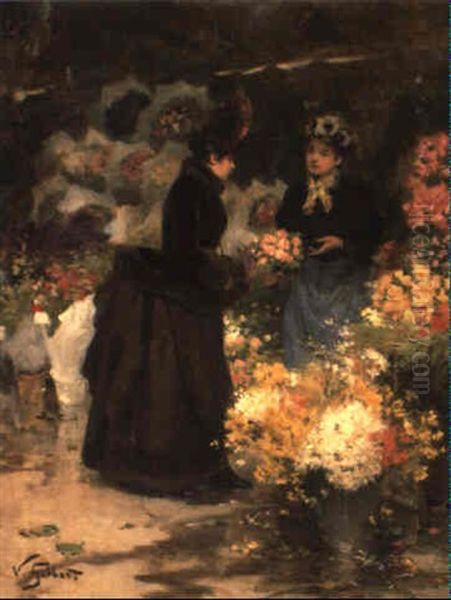
His paintings of Les Halles, in particular, serve as invaluable historical documents, preserving the look and feel of a central Parisian institution that has since been transformed. Beyond their documentary value, his works are celebrated for their artistic merit – their lively compositions, skillful handling of light, rich color harmonies, and sympathetic rendering of figures. He found poetry in the everyday, elevating market stalls, flower vendors, and playing children into subjects worthy of fine art.
Today, Victor Gabriel Gilbert's paintings are held in numerous museum collections, including the Musée d'Orsay and Musée Carnavalet in Paris, the Musée des Beaux-Arts de Bordeaux, and institutions in Lille, Strasbourg, and Liège, as well as many private collections worldwide. His work continues to be appreciated by collectors and the public for its accessibility, technical skill, and nostalgic evocation of a bygone Paris. He remains a beloved chronicler of his city, an artist whose dedication to capturing the life around him created a lasting and endearing body of work.